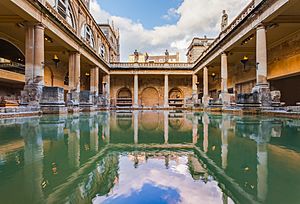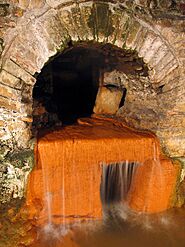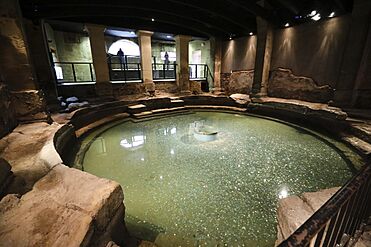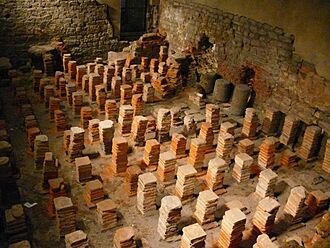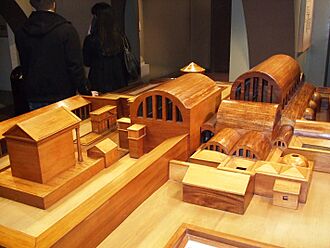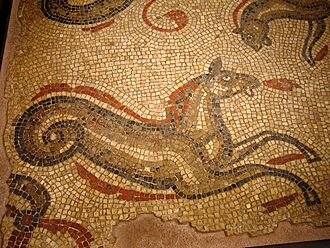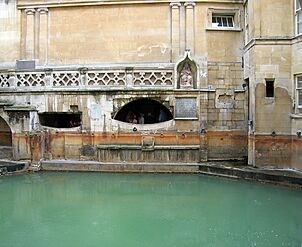Roman Baths (Bath) facts for kids
Quick facts for kids The Roman Baths |
|
|---|---|
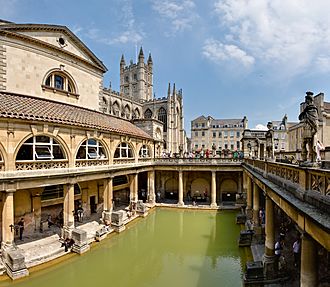
The Roman Baths in the city of Bath, England
|
|
| General information | |
| Town or city | Bath |
| Country | England |
| Coordinates | 51°22′51″N 2°21′34″W / 51.3809°N 2.3595°W |
| Construction started | Baths – 1st century Building – 1894 |
| Completed | 1897 |
| Design and construction | |
| Architect | John Brydon (museum building) |
The Roman Baths are ancient public baths found in the city of Bath, Somerset, England. They are very well-preserved. Around 60-70 AD, a temple was built here during the early days of Roman Britain. This temple led to the growth of a small Roman town called Aquae Sulis around the site. The Roman baths were used for public bathing until the end of Roman rule in Britain in the 5th century AD.
The Roman Baths today include four main parts: the Sacred Spring, the Roman Temple, the Roman Bath House, and a museum. The museum displays many ancient objects found at Aquae Sulis. The buildings you see at street level today were mostly built in the 1800s. The Roman Baths are a very popular place to visit in the UK. More than 1.3 million people visit them each year. Visitors can explore the baths and the museum, but they cannot go into the water.
Contents
Hot Spring Water
The water for the baths comes from rain that falls on the nearby Mendip Hills. This rainwater then slowly travels down through layers of limestone rock, reaching depths of about 2,700 to 4,300 meters (8,900 to 14,100 feet). Deep underground, the Earth's natural heat warms the water to temperatures between 69 and 96 °C (156 and 205 °F).
Under pressure, this hot water rises through cracks in the limestone until it bubbles up from the ground into the baths. Hot water at about 46 °C (115 °F) flows out at a rate of 1,170,000 liters (257,000 imperial gallons) every day. In 1982, a new well was dug. This provides clean, safe spa water for drinking in the Pump Room nearby.
Water Safety
The city of Bath has been in charge of the hot springs since 1591. Today, the local council monitors the water's pressure, temperature, and flow. The thermal water contains high levels of minerals like sodium, calcium, chloride, and sulfate.
The Roman Baths are no longer used for swimming. In 1978, a serious health issue occurred, leading to the decision that people should no longer swim in the ancient baths. Tests showed a dangerous germ in the water. However, modern visitors can still experience the thermal waters at the nearby Thermae Bath Spa and the refurbished Cross Bath. These modern spas use water from new boreholes.
History of the Baths
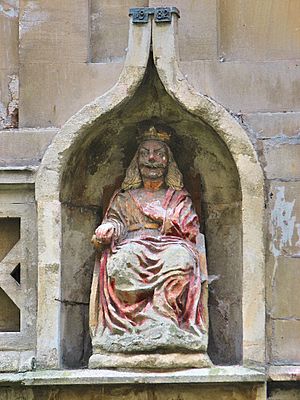
Archaeologists believe that the site of the baths was a special place for worship even before the Romans arrived. The natural springs were dedicated to a goddess named Sulis. The Celts, who lived in Britain at the time, believed Sulis was connected to the Roman goddess Minerva.
An old story, written by Geoffrey of Monmouth, tells how a pre-Roman British king named Bladud discovered the spring. He supposedly built the baths there. In the 1700s, this legend became very popular. It was said that the warm mud and water cured Bladud and his pigs of a skin disease.
Roman Times in Britain
The name Sulis continued to be used after the Romans invaded. This is why the Roman town was called Aquae Sulis, meaning "the waters of Sulis." The temple was built between 60 and 70 AD. The bathing complex grew steadily over the next 300 years.
During the Roman occupation, engineers used oak piles to create a strong foundation in the mud. They then built a stone chamber around the spring and lined it with lead. In the 2nd century, a wooden building with a curved roof was added. This building included the caldarium (hot bath), tepidarium (lukewarm bath), and frigidarium (cold bath).
After the Roman withdrawal from Britain in the early 5th century, the baths fell apart. They became filled with mud and were damaged by floods. The Anglo-Saxon Chronicle suggests the original Roman baths were destroyed in the 6th century.
About 130 "curse tablets" have been found at the site. Many of these curses were written by people who had their clothes stolen while they were bathing!
After the Romans Left
The baths have been changed many times over the centuries. In the 12th century, a curative bath was built over the King's Spring. In the 16th century, a new bath called the Queen's Bath was added. Anne of Denmark, a queen, visited Bath twice for her health in the early 1600s.
The spring is now housed in buildings from the 1700s. These were designed by architects John Wood, the Elder and John Wood, the Younger, who were father and son. Visitors used to drink the waters in the Grand Pump Room. This beautiful building is still used today for drinking the waters and for social events.
During the Victorian era, the bath complex was expanded. In 1810, people thought the hot springs had stopped flowing. However, a geologist named William Smith discovered that the water had simply found a new path. He was able to bring the water back to its original course.
The main entrance for visitors today is through a concert hall built in 1897. This building connects to the Grand Pump Room. The Grand Pump Room itself was started in 1789 and finished in 1799. It is a very important historic building.
Museum at the Baths
The museum at the Roman Baths displays many objects from the Roman period. These include items that were thrown into the Sacred Spring, probably as gifts to the goddess. More than 12,000 Roman coins have been found here, which is the largest collection of such offerings in Britain. A golden bronze head of the goddess Sulis Minerva, found in 1727, is also on display.
The Roman Temple stood on a raised platform, more than two meters (6.5 feet) above the courtyard. It had a flight of steps leading up to it. At the front, there were four large columns supporting a decorated triangular section called a pediment. Parts of this pediment are shown in the museum. It was about 8 meters (26 feet) wide and 2.4 meters (8 feet) tall at its highest point.
The pediment featured a powerful image of a "Gorgon head" that seemed to glare down at everyone approaching the temple. This large head has snakes in its beard, wings above its ears, and a heavy mustache. While Gorgons are usually female, scholars believe this one might be a mix of Minerva's Gorgon and a local god of the waters. It has also been thought to be a water god like Oceanus or a Celtic sun god.
In 2010, various stones on the pediment were carefully restored. A new learning center for schoolchildren, connected to the baths by a tunnel, opened in 2019.
Keeping the Baths Safe
The statues of Roman emperors and governors on the terrace overlooking the Great Bath were carved in the late 1800s. They are easily damaged by acid rain. To protect them, a special coating is applied every few years.
Inside the temple area, warm air can cause damaging salts to come out of the ancient Roman stonework. To help with this, a new ventilation system was put in place in 2006.
In 2009, a grant of £90,000 was given to help improve the displays and access at the Roman Baths. More grants have helped with the design and layout of the exhibitions.
Gallery
-
Model of the Roman Bath and Roman Temple of Sulis Minerva as they would have looked at their largest in the 4th century AD.
See also
 In Spanish: Termas romanas de Bath para niños
In Spanish: Termas romanas de Bath para niños
- List of Roman public baths


